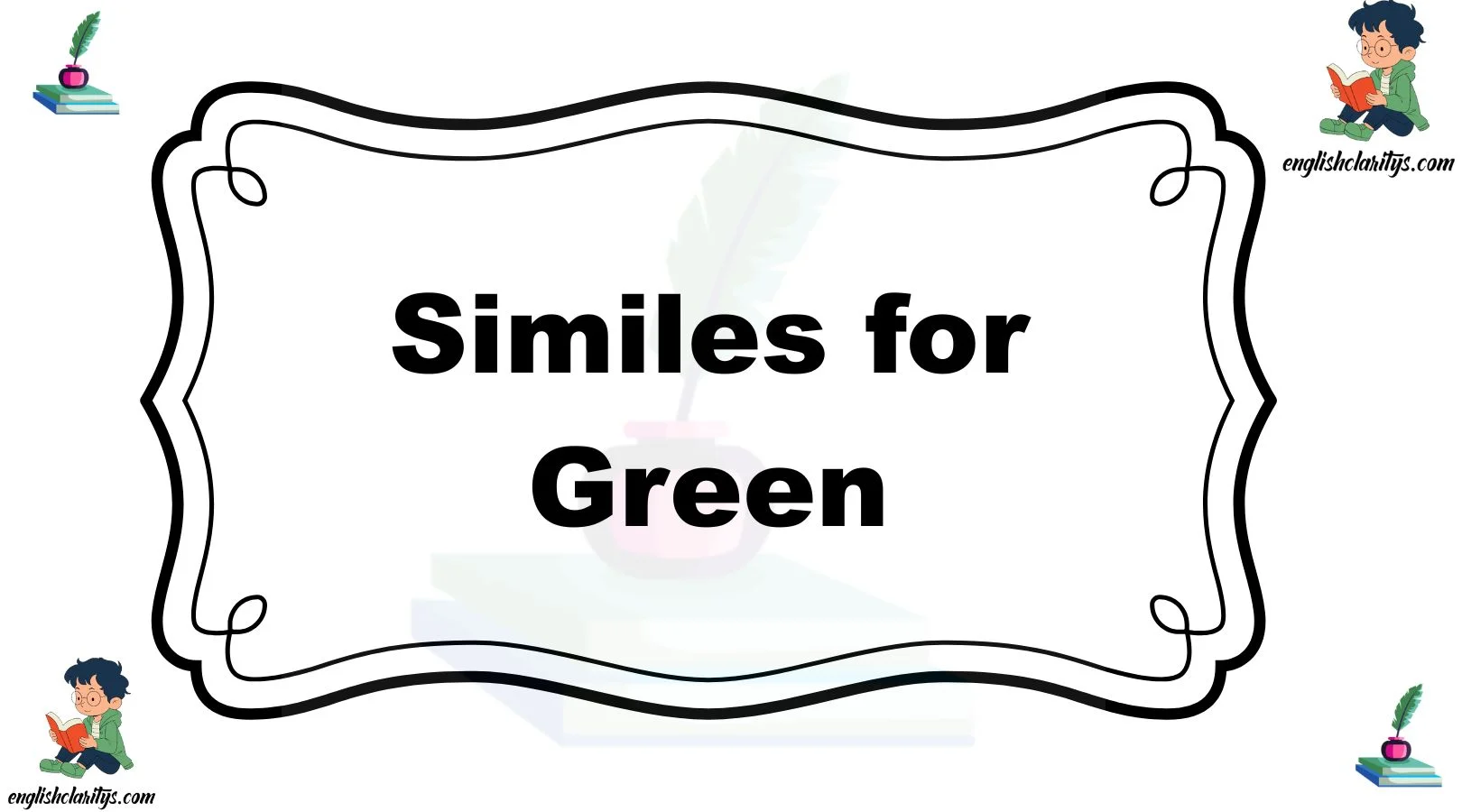Expressing ourselves clearly and warmly is such a wonderful way to connect with others. Finding the right words to describe something as vibrant and meaningful as the colour green can add layers of feeling and personality to your communication. Whether you’re writing poetry, describing nature, or simply trying to capture a moment, using similes can make your message feel more personal and memorable.
In this article, we’ll explore 25 beautiful and thoughtful similes for green, each with explanations, examples, and tips on when and how to use them. These alternatives will help you express the essence of green with warmth and care, enriching your language with creativity.
What Does “Green” Mean?
The colour green symbolises growth, renewal, and harmony. It is often associated with nature, freshness, and tranquillity. When someone uses green in a simile, they are typically evoking feelings of vitality, balance, or new beginnings. Green can also represent youthfulness, envy, or inexperience depending on the context. Understanding the deeper meaning of green allows you to choose the best simile that fits the emotion or image you want to convey.
When to Use “Green”
Use similes related to green when you want to describe anything vibrant, natural, or refreshing. They work wonderfully in creative writing, descriptive scenes, or when complimenting someone’s freshness or youth. Green similes can also be used metaphorically — for example, to describe someone’s naivety (“green as a new leaf”) or envy (“green with jealousy”). These expressions can add depth and warmth to your language.
Pros and Cons of Using Green Similes
Pros:
- Green similes bring vivid imagery to your writing and speech.
- They help express complex emotions like growth or envy in relatable ways.
- They are versatile and can fit many tones, from playful to serious.
Cons:
- Overusing common green similes like “green as grass” can feel cliché.
- Some green similes may be misunderstood if the audience isn’t familiar with the metaphorical meaning.
- Using green to describe envy might seem negative if not carefully phrased.
1. Green as Fresh Spring Leaves
Definition: This simile compares green to the vibrant, fresh color of new leaves in spring.
Explanation: It evokes renewal, growth, and freshness.
Example: Her eyes were green as fresh spring leaves, full of hope and promise.
Best Use: Use this when describing something lively, youthful, or new.
Tone: Warm, hopeful, uplifting.
Other Ways to Say It:
- Green like budding leaves
- Green as early spring foliage
- Green like new growth
2. Green as Emeralds
Definition: This compares green to the deep, rich color of emerald gemstones.
Explanation: It conveys luxury, depth, and beauty.
Example: The garden shimmered with flowers green as emeralds under the sunlight.
Best Use: When describing something precious, vivid, or captivating.
Tone: Elegant, rich, admiring.
Other Ways to Say It:
- Green like precious gems
- Green as jade
- Green like rare stones
3. Green as the Meadow After Rain
Definition: This simile uses the lush green of a meadow revitalized by rain.
Explanation: It highlights freshness and rejuvenation.
Example: The field looked green as the meadow after rain, glowing with life.
Best Use: Use in nature descriptions or to imply revival.
Tone: Fresh, calm, peaceful.
Other Ways to Say It:
- Green like a soaked pasture
- Green as wet grass
- Green like nature’s refresh
4. Green as a Granny Smith Apple
Definition: Comparing green to the bright and tangy shade of a Granny Smith apple.
Explanation: It suggests crispness and vitality.
Example: Her dress was green as a Granny Smith apple, vibrant and eye-catching.
Best Use: To describe freshness or a zesty vibe.
Tone: Energetic, playful.
Other Ways to Say It:
- Green like tart apples
- Green as sour fruit
- Green like fresh produce
5. Green as Moss on Ancient Stones
Definition: Green compared to the soft moss covering old stones.
Explanation: It evokes age, quiet beauty, and nature reclaiming space.
Example: The forest floor was green as moss on ancient stones, serene and untouched.
Best Use: For peaceful, natural, and slightly mysterious settings.
Tone: Calm, contemplative.
Other Ways to Say It:
- Green like forest moss
- Green as lichen-covered rocks
- Green like shaded woods
6. Green as a Frog’s Skin
Definition: Comparing green to the bright or muted shade of a frog’s skin.
Explanation: It’s playful and natural.
Example: His eyes were green as a frog’s skin, full of curiosity.
Best Use: When you want a lighthearted, nature-based image.
Tone: Fun, natural.
Other Ways to Say It:
- Green like amphibians
- Green as pond life
- Green like wet frogs
7. Green as Freshly Mown Grass
Definition: The green of freshly cut, lush grass.
Explanation: It symbolizes neatness, vitality, and summer warmth.
Example: The backyard was green as freshly mown grass, inviting and alive.
Best Use: Describing neat, vibrant outdoor spaces.
Tone: Warm, inviting.
Other Ways to Say It:
- Green like trimmed lawns
- Green as summer fields
- Green like a garden after mowing
8. Green as Ivy on Old Walls
Definition: Green like the climbing ivy that covers walls.
Explanation: Suggests persistence, growth, and charm.
Example: Her scarf was green as ivy on old walls, elegant and timeless.
Best Use: For descriptions involving age and natural beauty.
Tone: Classic, graceful.
Other Ways to Say It:
- Green like creeping vines
- Green as wall ivy
- Green like garden climbers
9. Green as a Turtle’s Shell
Definition: The green shade of a turtle’s shell.
Explanation: Symbolizes resilience and nature’s armor.
Example: The sculpture was green as a turtle’s shell, rugged yet beautiful.
Best Use: For describing strength or nature-inspired art.
Tone: Strong, natural.
Other Ways to Say It:
- Green like reptile shells
- Green as a terrapin
- Green like slow-moving creatures
10. Green as a Lime’s Peel
Definition: The bright green of a lime’s outer skin.
Explanation: Suggests zest, freshness, and sharpness.
Example: Her mood was green as a lime’s peel, tangy and refreshing.
Best Use: When describing something lively and sharp.
Tone: Fresh, energetic.
Other Ways to Say It:
- Green like citrus skin
- Green as sour fruit peel
- Green like fresh limes
11. Green as Spinach Leaves
Definition: The deep green of fresh spinach leaves.
Explanation: Represents health and natural goodness.
Example: The smoothie was green as spinach leaves, wholesome and vibrant.
Best Use: Describing health, nutrition, or freshness.
Tone: Healthy, nurturing.
Other Ways to Say It:
- Green like leafy greens
- Green as kale leaves
- Green like garden harvest
12. Green as a Parrot’s Feathers
Definition: Bright, eye-catching green like parrot feathers.
Explanation: Symbolizes vibrancy and exotic beauty.
Example: Her dress was green as a parrot’s feathers, bold and beautiful.
Best Use: For lively, colorful imagery.
Tone: Playful, bold.
Other Ways to Say It:
- Green like tropical birds
- Green as exotic plumage
- Green like rainforest wings
13. Green as Fresh Peas in a Pod
Definition: The soft, fresh green of peas.
Explanation: Represents freshness and abundance.
Example: The salad was green as fresh peas in a pod, crisp and sweet.
Best Use: For food descriptions or freshness.
Tone: Wholesome, fresh.
Other Ways to Say It:
- Green like garden peas
- Green as podded vegetables
- Green like spring harvest
14. Green as Algae in a Pond
Definition: The natural green of algae floating in water.
Explanation: Suggests calm, natural life.
Example: The pond was green as algae, peaceful yet full of life.
Best Use: For tranquil water scenes.
Tone: Serene, natural.
Other Ways to Say It:
- Green like pond plants
- Green as water moss
- Green like aquatic growth
15. Green as a Freshly Picked Cabbage
Definition: The leafy, crisp green of cabbage.
Explanation: Symbolizes freshness and garden bounty.
Example: The market was full of greens as fresh as cabbage leaves.
Best Use: Describing freshness, harvest.
Tone: Earthy, natural.
Other Ways to Say It:
- Green like leafy vegetables
- Green as garden produce
- Green like farm harvest
16. Green as Mint Leaves
Definition: The cool, refreshing green of mint.
Explanation: Suggests freshness, coolness, and energy.
Example: The drink was green as mint leaves, crisp and invigorating.
Best Use: For fresh, cooling descriptions.
Tone: Refreshing, lively.
Other Ways to Say It:
- Green like aromatic herbs
- Green as peppermint
- Green like fresh herbs
17. Green as a Kiwi’s Skin
Definition: The fuzzy greenish skin of a kiwi fruit.
Explanation: Represents uniqueness and exotic freshness.
Example: Her jacket was green as a kiwi’s skin, soft and unusual.
Best Use: For describing unique, quirky freshness.
Tone: Fun, distinctive.
Other Ways to Say It:
- Green like tropical fruits
- Green as fuzzy skin
- Green like exotic produce
18. Green as a Rainforest Canopy
Definition: The lush, deep green of rainforest treetops.
Explanation: Evokes richness and dense vitality.
Example: The view was green as a rainforest canopy, endless and alive.
Best Use: Describing abundance and natural beauty.
Tone: Rich, vibrant.
Other Ways to Say It:
- Green like jungle leaves
- Green as tropical forests
- Green like dense foliage
19. Green as Pea Soup
Definition: The thick, bright green color of pea soup.
Explanation: Suggests warmth and homeliness.
Example: The kitchen smelled of green as pea soup, comforting and hearty.
Best Use: For cozy, comforting scenes.
Tone: Warm, inviting.
Other Ways to Say It:
- Green like hearty soups
- Green as comfort food
- Green like homemade dishes
20. Green as a Caterpillar
Definition: The bright green of a caterpillar’s body.
Explanation: Symbolizes transformation and new beginnings.
Example: Her thoughts were green as a caterpillar, full of change and hope.
Best Use: When describing growth or transformation.
Tone: Hopeful, reflective.
Other Ways to Say It:
- Green like larva
- Green as nature’s beginnings
- Green like early life stages
21. Green as a Shamrock
Definition: The iconic green of a shamrock leaf.
Explanation: Represents luck and Irish heritage.
Example: The fields were green as shamrocks on St. Patrick’s Day.
Best Use: For cultural, lucky, or festive imagery.
Tone: Cheerful, optimistic.
Other Ways to Say It:
- Green like clovers
- Green as lucky leaves
- Green like festive foliage
22. Green as a Grasshopper
Definition: The vivid green of a grasshopper.
Explanation: Suggests agility and nature’s vibrancy.
Example: She moved with a graceful green grasshopper.
Best Use: For lively, energetic descriptions.
Tone: Playful, agile.
Other Ways to Say It:
- Green like jumping insects
- Green as spring creatures
- Green like meadow life
23. Green as Celery Stalks
Definition: The pale green of celery.
Explanation: Evokes freshness and crispness.
Example: The salad was green as celery stalks, light and crunchy.
Best Use: For fresh, crisp food imagery.
Tone: Clean, fresh.
Other Ways to Say It:
- Green like crunchy veggies
- Green as salad ingredients
- Green like healthy snacks
24. Green as Avocado Flesh
Definition: The creamy green inside an avocado.
Explanation: Suggests richness and health.
Example: The smoothie had a green avocado flesh, smooth and nourishing.
Best Use: For healthy, creamy descriptions.
Tone: Nutritious, comforting.
Other Ways to Say It:
- Green like creamy fruit
- Green as buttery flesh
- Green like superfoods
25. Green as Fresh Bamboo Shoots
Definition: The pale to bright green of bamboo shoots.
Explanation: Represents resilience and fresh starts.
Example: Her spirit was green as fresh bamboo shoots, strong and new.
Best Use: For resilience and growth imagery.
Tone: Strong, hopeful.
Other Ways to Say It:
- Green like young bamboo
- Green as new stalks
- Green like forest sprouts
Conclusion:
Using similes for green allows you to express this beautiful color with depth and personality. From the freshness of spring leaves to the luxury of emeralds, each simile brings a unique tone—whether it’s hopeful, elegant, playful, or nurturing. Understanding the meaning behind green and choosing your simile carefully helps you communicate with warmth and thoughtfulness. Let these expressions inspire you to add vivid imagery and heartfelt emotion to your words.
MCQs:
1. Which simile best conveys the idea of luxury and richness in green?
A) Green as fresh spring leaves
B) Green as emeralds
C) Green as moss on stones
D) Green as celery stalks
2. “Green as a Granny Smith apple” is best used to describe something:
A) Old and faded
B) Crisp and vibrant
C) Dark and mysterious
D) Soft and fuzzy
3. What tone does “green as moss on ancient stones” suggest?
A) Playful
B) Calm and contemplative
C) Energetic
D) Harsh
4. Which simile is most suitable for describing transformation and new beginnings?
A) Green as a turtle’s shell
B) Green as a caterpillar
C) Green as lime peel
D) Green as pea soup
5. “Green as freshly mown grass” is best for describing:
A) A messy field
B) A neat, vibrant outdoor space
C) A dry desert
D) A frozen lake
6. Which green simile evokes freshness and coolness?
A) Green as mint leaves
B) Green as grasshopper
C) Green as a kiwi’s skin
D) Green as a shamrock
7. Which of these green similes implies resilience?
A) Green as bamboo shoots
B) Green as avocado flesh
C) Green as celery stalks
D) Green as pea soup
8. Which simile would best describe something exotic and colorful?
A) Green as emeralds
B) Green as parrot’s feathers
C) Green as moss
D) Green as spinach leaves
9. When describing something youthful and hopeful, which simile fits best?
A) Green as freshly picked cabbage
B) Green as fresh spring leaves
C) Green as algae in a pond
D) Green as pea soup
10. Which green simile is commonly associated with luck?
A) Green as shamrocks
B) Green as grasshopper
C) Green as turtle’s shell
D) Green as lime peel
11. What is the best use of “green as algae in a pond”?
A) Describing lively cities
B) Tranquil water scenes
C) Busy streets
D) Desert landscapes
12. Which tone matches “green as pea soup”?
A) Harsh
B) Warm and inviting
C) Cold and distant
D) Playful
13. Which green simile is linked with health and nutrition?
A) Green as spinach leaves
B) Green as moss on stones
C) Green as emeralds
D) Green as kiwi’s skin
14. Which simile would best describe a refreshing drink?
A) Green as freshly picked cabbage
B) Green as mint leaves
C) Green as pea soup
D) Green as turtle’s shell
15. What is the best tone for “green as a grasshopper”?
A) Playful and agile
B) Serious and somber
C) Elegant and rich
D) Calm and peaceful
Answers:
- B) Green as emeralds
- B) Crisp and vibrant
- B) Calm and contemplative
- B) Green as a caterpillar
- B) A neat, vibrant outdoor space
- A) Green as mint leaves
- A) Green as bamboo shoots
- B) Green as parrot’s feathers
- B) Green as fresh spring leaves
- A) Green as shamrocks
- B) Tranquil water scenes
- B) Warm and inviting
- A) Green as spinach leaves
- B) Green as mint leaves
- A) Playful and agile
FAQs:
1. What is a simile for green?
A simile for green is a figure of speech that compares the color green to something else using the words “like” or “as.” These comparisons help bring vivid, emotional, or descriptive clarity to writing—for example, “green as fresh spring leaves” or “green like emeralds.”
2. Why should I use similes for green in my writing?
Using similes for green adds depth, imagery, and emotional tone to your writing. It helps your readers or listeners visualize what you’re describing and connect more personally with your message, especially in poetry, storytelling, or expressive speech.
3. Are similes only used in creative writing?
No, not at all. Similes are used in everyday communication, advertising, public speaking, and professional writing to make language more engaging and relatable. A thoughtful simile like “green as bamboo shoots” can make even a casual message more meaningful.
4. What’s the difference between a simile and a metaphor for green?
A simile uses “like” or “as” (“green as a parrot’s feathers”), while a metaphor states something is something else without using those words (“Her eyes were emerald pools”). Both are powerful tools, but similes tend to be more direct and accessible.
5. How can I create my own simile for green?
To create your own simile, think of something vividly green and consider the emotion or idea you want to express. Then structure your phrase like this:
“Green as [something familiar and meaningful]”.
For example, “Green as hope in early spring” or “Green like laughter in a garden.” Personal connections make similes more heartfelt and unique.




